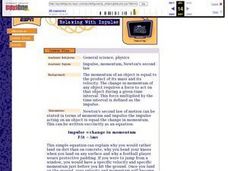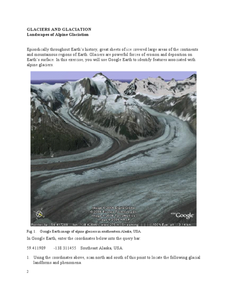Curated OER
Wildlife
The centerpiece of this lesson plan is a predator-prey simulation in which colored paperclips represent different species of animals camouflaged against a colored background. Relevant follow-up questions are provided. The activity is...
Curated OER
Cartographer on Assignment: Creating a Physical Map of Africa
Students use geographic information to make an outline map of Africa, then demonstrate their understanding of the physical landscape of Africa by using a variety of materials to create a physical map of Africa
Curated OER
Relaxing with Impulse
Pupils discuss Newton's second law of motion in terms of momentum and impulse using examples of landing on concrete versus dirt if you were to jump off an elevated platform or football players wearing protective padding. Mathematical...
Curated OER
The United States and Canada: Climate and Vegetation
Display U.S. and Canadian climate and vegetation through this text-companion worksheet. Learners read about the geography of these regions, take notes, and answer 3 comprehension questions as they read the selection. A graphic organizer...
Curated OER
Tide Pool Discovery
First graders visit the Discovery Pool, where they use their senses to investigate the different tide pool species. They touch different species. Students describe how each one feels, and what they look like in words. They draw the...
Curated OER
Mapping My Community
Ninth graders are introduced to GPS technology. They complete fieldwork as they visit a specific area of their community to identify and map types of land use in the surveyed area. They use the collected data to create a digital map.
Curated OER
The Planning Commission
Students design a sound community. In this communities lesson, students take on the role of city planners and identify the needs of the community. Students develop a blue print to meet the needs of the community and include new...
Curated OER
What's The Level?
Young scholars examine the movement of the water table and saturation zones. They describe the movements of the water table and locate the saturation zones. Students identify the function of each saturation zone. They develop a model of...
Curated OER
Physical Geography of Africa
Fifth graders investigate the topography of Africa. For this physical geography lesson, 5th graders research the six regions of Africa and complete a physical map. Students locate various landforms in Africa. Students...
Curated OER
'Tis a Long, Long Way to Tipperary!
Students practice finding the location of cities across the world by using an interactive Web site, and figure out the world's time and the value of time zones the world over.
Curated OER
Exploring The Oceans
In this science activity, students look for the information in order to answer the basic facts concerning common marine life using puzzles.
Curated OER
Landscapes of Alpine Glaciation
In this glaciers worksheet, students use Google Earth to look for examples of different glacial landforms and phenomena. Students complete 2 short answer questions.
Curated OER
'Round and 'Round it Goes!
Students discuss and interpret background knowledge on poster copy given on the water cycle. Students complete the included activity sheets using the poster as a reference in small groups. Students identify and name where water can be...
Curated OER
Pilots, Airplanes, and the Tangent of Three Degrees
Students explore how to use trigonometry in the aviation field. In this aviation instructional activity students complete trigonometry equations that show what planes should do to land their airplanes.
Curated OER
Model of a Well
Students complete an experiment using wire screening, wires, water, sand, and food coloring to compare the relationship of groundwater to wells. In this water lesson plan, students observe and record what they see after they complete the...
Curated OER
LRO-Searching for Lunar Boulders
In this lunar boulders activity, students use an image taken by the LRO satellite of the surface of the moon to find the scale of the image and determine the number of boulders and their approximate sizes.
Curated OER
The Geophysics And Cultural Aspects of the Greater Antilles
Students determine location by using longitude and latitude. They measure to the minute longitude and latitude of a place and select a body of land and determine its location. They approximate time zones by using every 15 degrees of...
Curated OER
Let's Go To Mexico
Students are able to use the Internet to conduct research. They research Mexican culture and traditions. Students compare and contrast Mexican and U.S. food and clothing. They convert United States currency to Mexican pesos. Students...
Mr. E. Science
Climate and Climate Change
What factors make up climate? How does longitude and latitude affect climate? What is causing Earth's climate to change? These questions are the topic of a presentation that explains characteristics of climate and climate change.
Mrs. Robbins' Social Studies Site
The Berlin Blockade
The Berlin Blockade may not take up as much space in the history books as other events of the Cold War, but for the citizens of west Berlin in 1948—and the events to follow between the Soviet Union and the United Stattes—those 318 days...
Curated OER
Tides and How Creatures Survive
Students discover tidal pools. In this oceanographic lesson, students observe the tides of the earth and the creatures that inhabit the intertidal zones. Students role-play the tidal zones by portraying themselves as animals...
Curated OER
Who Are Travellers?
High schoolers visit specified websites to research zoning information in Essex. They participate in a role play to present a zoning request to a city council. Groups of students prepare their side of the case and create their proposal...
Curated OER
Community Centered Neighborhood Development
Ninth graders explore the culture of the neighborhood. In this Social Studies lesson, 9th graders examine the different development sites in their community. Students research the zoning regulations.
Curated OER
Drop Zone! Design and Test a Probe
Students work together to develop their own parachuting probe. They test it and record the results. They simulate other experiments that are going to be carried out by the Huygens probe.























